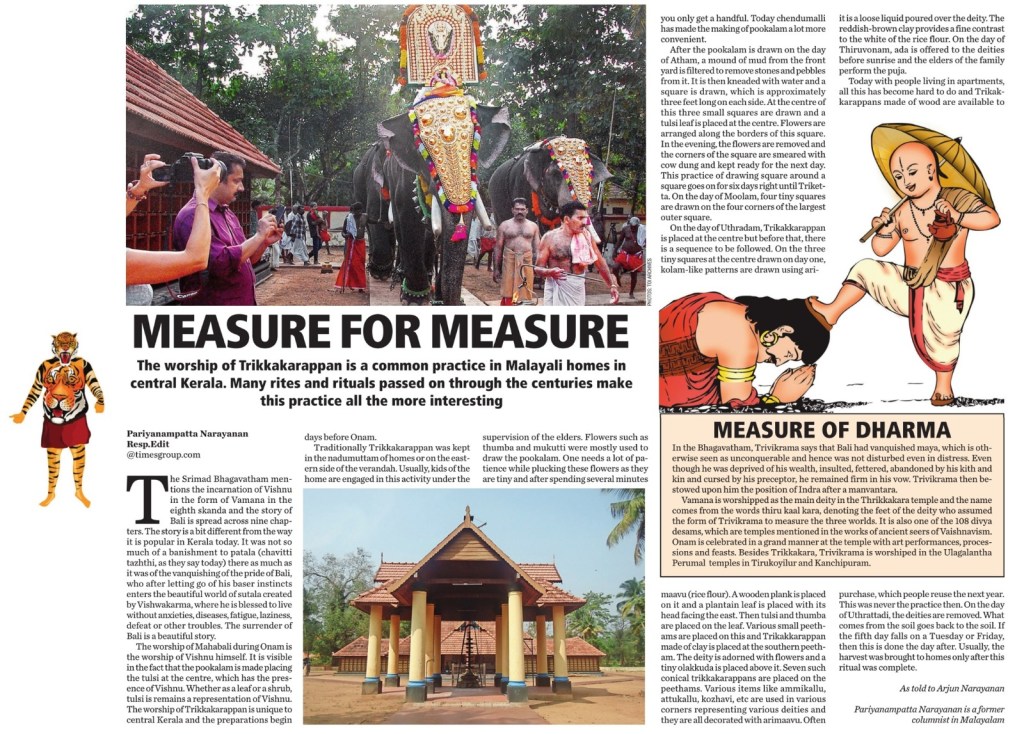
The Srimad Bhagavatham mentions the incarnation of Vishnu in the form of Vamana in the eighth skanda and the story of Bali is spread across nine chapters. The story is a bit different from the way it is popular in Kerala today. It was not so much of a banishment to patala (chavitti tazhthi, as they say today) there as much as it was of the vanquishing of the pride of Bali, who after letting go of his baser instincts enters the beautiful world of sutala created by Vishwakarma, where he is blessed to live without anxieties, diseases, fatigue, laziness, defeat, or other troubles. The surrender of Bali is a beautiful story.
The worship of Mahabali during Onam is the worship of Vishnu himself. It is visible in the fact that the pookalam is made placing the tulsi at the centre, which has the presence of Vishnu. Whether as a leaf or a shrub, tulsi is remains a representation of Vishnu. The worship of Trikkakarappan is unique to central Kerala and the preparations begin days before Onam.
Traditionally Trikkakarappan was kept in the nadumuttam of homes or on the eastern side of the verandah. Usually, kids of the home are engaged in this activity under the supervision of the elders. Flowers such as thumba and mukutti were mostly used to draw the pookalam. One needs a lot of patience while plucking these flowers as they are tiny and after spending several minutes you only get a handful. Today chendumalli has made the making of pookalam a lot more convenient.
After the pookalam is drawn on the day of Atham, a mound of mud from the front yard is filtered to remove stones and pebbles from it. It is then kneaded with water and a square is drawn, which is approximately three feet long on each side. At the centre of this three small squares are drawn and a tulsi leaf is placed at the centre. Flowers are arranged along the borders of this square. In the evening, the flowers are removed and the corners of the square are smeared with cow dung and kept ready for the next day. This practice of drawing square around a square goes on for six days right until Triketta. On the day of Moolam, four tiny squares are drawn on the four corners of the largest outer square.
On the day of Uthradam, Trikakkarappan is placed at the centre but before that, there is a sequence to be followed. On the three tiny squares at the centre drawn on day one, kolam-like patterns are drawn using arimaavu (rice flour). A wooden plank is placed on it and a plantain leaf is placed with its head facing the east. Then tulsi and thumba are placed on the leaf. Various small peethams are placed on this and Trikakkarappan made of clay is placed at the southern peetham. The deity is adorned with flowers and a tiny olakkuda is placed above it. Seven such conical trikkakarappans are placed on the peethams. Various items like ammikallu, attukallu, kozhavi, etc are used in various corners representing various deities and they are all decorated with arimaavu. Often it is a loose liquid poured over the deity. The reddish brown clay provides a fine contrast to the white of the rice flour. On the day of Thiruvonam, ada is offered to the deities before sunrise and the elders of the family perform the puja.
Today with people living in apartments, all this has become hard to do and trikakkarappans made of wood are available to purchase, which people reuse the next year. This was never the practice then. On the day of Uthrattadi, the deities are removed. What comes from the soil goes back to the soil. If the fifth day falls on a Tuesday or Friday, then this is done the day after. Usually, the harvest was brought to homes only after this ritual was complete.
(Spoke to Thrissur-based columnist Pariyanampatta Narayanan for this piece)
The deity of Trikkakara temple
In the Bhagavatham, Trivikrama says that Bali had vanquished maya, which is otherwise seen as unconquerable and hence was not disturbed even in distress. Even though he was deprived of his wealth, insulted, fettered, abandoned by his kith and kin and cursed by his preceptor, he remained firm in his vow. Trivikrama then bestowed upon him the position of Indra after a manvantara.
Vamana is worshipped as the main deity in the Thrikkakara temple and the name comes from the words thiru kaal kara, denoting the feet of the deity who assumed the form of Trivikrama to measure the three worlds. It is also one of the 108 divya desams, which are temples mentioned in the works of ancient seers of Vaishnavism. Onam is celebrated in a grand manner at the temple with art performances, processions and feasts. Besides Trikkakara, Trivikrama is worshiped in the Ulagalantha Perumal temples in Tirukoyilur and Kanchipuram.

Leave a comment